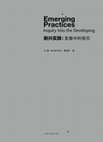Papers by Canan Emine Unlu
Ottagono: rivista trimestrale di architettura, arredamento e industrial design, 2002
... | Ayuda. Donne, design e Turchia. Autores: Canan E.Unlu; Localización: Ottagono: rivista trim... more ... | Ayuda. Donne, design e Turchia. Autores: Canan E.Unlu; Localización: Ottagono: rivista trimestrale di architettura, arredamento e industrial design, ISSN 0391-7487, Nº 148, 2002 , pag. 49. © 2001-2011 Universidad de La Rioja · Todos los derechos reservados. ...
Ottagono, 2002
... | Ayuda. Donne, design e Turchia. Autores: Canan E.Unlu; Localización: Ottagono: rivista trim... more ... | Ayuda. Donne, design e Turchia. Autores: Canan E.Unlu; Localización: Ottagono: rivista trimestrale di architettura, arredamento e industrial design, ISSN 0391-7487, Nº 148, 2002 , pag. 49. © 2001-2011 Universidad de La Rioja · Todos los derechos reservados. ...

Basic Design, the rst year foundation course of METU’s Industrial Design Department, leads stude... more Basic Design, the rst year foundation course of METU’s Industrial Design Department, leads students gradually from two-dimensional to three-dimensional abstract compositions. As the assignments gain volume, students experiment with the play of light and shadow that is essential
for volume perception and crucial for the professional development of prospective industrial designers. Through the years of teaching Basic Design, authors observed that, students have tendency to accept light as a default and uncontrollable (or not necessary to control) outside factor for the forms they designed; and, they have dif culty to realize it’s role as a primary design element on their designs. In recent years, a teaching approach dealing particularly with light and shadow was developed: it’s dwelled upon the effects of light onto 3D forms and intentional use of arti cial lighting was incorporated into the basic design compositions. The design works
were expected to be “successful” whether they were lighted arti cially or in natural light. However, students were not expected to consider seriously the issues such as production, product-user relationship or consumer behavior which are the concerns of other courses or further grades. The mentioned approach was repeated on four different projects between 2008 and 2014, with different basic design problem briefs each time. Experimenting with different levels of transparency through use of materials as well as structure, emphasizing the volume of an object and creating an ambience in the environment through light were the main challenges of the projects. Through examining the design processes of these projects as well as the results, valuable conclusions were taken on integrating light as a design element to the foundation education of industrial design students.











Uploads
Papers by Canan Emine Unlu
for volume perception and crucial for the professional development of prospective industrial designers. Through the years of teaching Basic Design, authors observed that, students have tendency to accept light as a default and uncontrollable (or not necessary to control) outside factor for the forms they designed; and, they have dif culty to realize it’s role as a primary design element on their designs. In recent years, a teaching approach dealing particularly with light and shadow was developed: it’s dwelled upon the effects of light onto 3D forms and intentional use of arti cial lighting was incorporated into the basic design compositions. The design works
were expected to be “successful” whether they were lighted arti cially or in natural light. However, students were not expected to consider seriously the issues such as production, product-user relationship or consumer behavior which are the concerns of other courses or further grades. The mentioned approach was repeated on four different projects between 2008 and 2014, with different basic design problem briefs each time. Experimenting with different levels of transparency through use of materials as well as structure, emphasizing the volume of an object and creating an ambience in the environment through light were the main challenges of the projects. Through examining the design processes of these projects as well as the results, valuable conclusions were taken on integrating light as a design element to the foundation education of industrial design students.
for volume perception and crucial for the professional development of prospective industrial designers. Through the years of teaching Basic Design, authors observed that, students have tendency to accept light as a default and uncontrollable (or not necessary to control) outside factor for the forms they designed; and, they have dif culty to realize it’s role as a primary design element on their designs. In recent years, a teaching approach dealing particularly with light and shadow was developed: it’s dwelled upon the effects of light onto 3D forms and intentional use of arti cial lighting was incorporated into the basic design compositions. The design works
were expected to be “successful” whether they were lighted arti cially or in natural light. However, students were not expected to consider seriously the issues such as production, product-user relationship or consumer behavior which are the concerns of other courses or further grades. The mentioned approach was repeated on four different projects between 2008 and 2014, with different basic design problem briefs each time. Experimenting with different levels of transparency through use of materials as well as structure, emphasizing the volume of an object and creating an ambience in the environment through light were the main challenges of the projects. Through examining the design processes of these projects as well as the results, valuable conclusions were taken on integrating light as a design element to the foundation education of industrial design students.